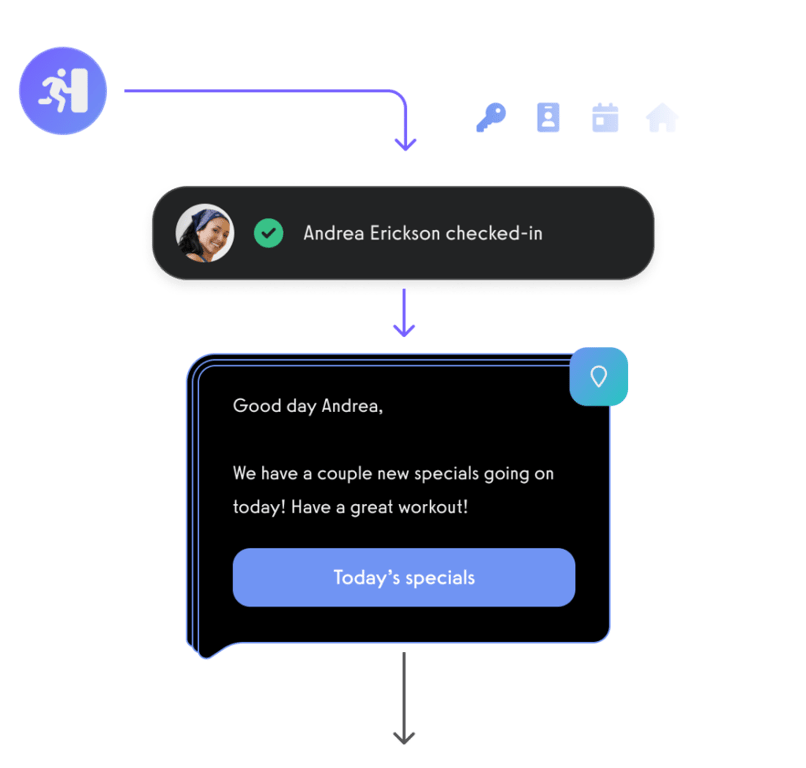Platform
Solutions
Industries
Compare
Resources
Posted by on May 16, 2025 — Updated on September 13, 2025
Thinking about offering childcare at your gym? We break down gym childcare pros, cons, legal considerations, and how Exercise.com can help manage the details.

Should a gym offer childcare? Many gyms and fitness studios consider it a competitive advantage—but it also comes with added costs, liability, and operational complexity. From gym childcare hours and gym insurance requirements to childcare software integrations and parent communications, successful implementation depends on more than just a spare room.

With Exercise.com’s best gym management software, gym owners can streamline scheduling, automate waivers, and create custom access permissions—making it easier to offer childcare safely and efficiently.

For many parents, a gym membership with daycare is the deciding factor when choosing between competing facilities. Families often ask what gyms have childcare or compare fitness centers with childcare before committing to a long-term membership. This makes offering gym childcare services a competitive differentiator, especially for boutique studios and full-service gyms trying to boost ARPM and retention. By aligning your childcare policy with member expectations, you can attract a demographic that typically has higher lifetime value due to bundled family memberships and consistent attendance. For guidance on structuring long-term offerings beyond childcare, see our resource on fitness business ideas.
| Category | Details |
|---|---|
| Popular States with Childcare Regulations | California, Texas, Florida (check local health and safety codes) |
| Common Liability Needs | Gym childcare insurance, staff background checks, parental waivers |
| Space Requirements | Minimum square footage per child; childproofed and separate area |
| Staffing Guidelines | Qualified, CPR-certified caregivers; consistent scheduling system |
| Pricing Strategies | Included in premium memberships or $5–$10 per child per visit |
| Software Features Needed | Check-in tracking, waiver automation, parent-child account linking, role-based access |
| Exercise.com Tools | Custom-branded app, digital waivers, attendance tracking, smart access control, automated billing |
So, is childcare in a gym a solution or a stress for you, the gym owner?
For many gym owners, especially in suburban or family-focused markets, adding childcare services seems like an easy win. Parents get a workout, kids stay supervised, and memberships grow.
But as anyone who has tried it knows, the reality can get complicated fast.
Add in the fact that many gym management systems don’t support family-linked memberships or dual check-ins, and it’s easy to see why childcare becomes more hassle than help.
That’s why gyms using Exercise.com are ahead of the game. With custom waivers, automated family accounts, parent/dependent relationships, and flexible scheduling tools, they can easily manage childcare operations and deliver the seamless member experience parents expect.


1. Increase Gym Memberships
2. Competitive Differentiation
3. Higher Lifetime Value
4. Supports Group Training Attendance
5. Community Building
1. Liability Risks
2. Staffing Costs
3. State-Level Regulations
4. Operational Complexity
5. Space Trade-Offs
Childcare can be an incredible retention tool, but it comes with operational complexity. Staffing is the number one challenge—following best practices for scheduling childcare staff at gyms requires balancing safety ratios, cost controls, and member demand. Without the right system, gyms either overstaff (eroding margins) or understaff (leading to poor service). Using a platform like Exercise.com, you can integrate childcare scheduling directly into your staff coverage plan, alongside group fitness classes and training sessions. This ensures your gym childcare facilities remain compliant, efficient, and profitable. If you’re still mapping out operational workflows, our guide on how to open a gym provides frameworks for staffing models and payroll ratios.
The benefits of gym childcare facilities are clear: improved retention, higher family membership sales, and increased visit frequency among parents. However, gym owners must weigh these benefits against liability, space allocation, and insurance costs. A poorly implemented example gym childcare policy could expose your business to risk if safety procedures are not standardized. Exercise.com allows you to manage digital waivers, track staff certifications, and integrate childcare reservations into your custom-branded app. This level of control transforms childcare from a liability into a structured service line. For more on creating family-friendly programming that boosts profitability, check out our guide on how to make money from fitness.
If your current gym software doesn’t let you do these things quickly and reliably, then you need a better system.
If you’re exploring gym childcare cost structures, waiver automations, or secure mobile check-ins for parents, Exercise.com has everything you need in one platform:
You can even lock and unlock access to the childcare area via smart scheduling and role-based controls—ensuring only eligible members and staff are granted access during gym childcare hours.

If you have the space, staff, and community demand, offering childcare can absolutely boost your gym’s appeal. But without the right systems in place, it becomes a liability nightmare. (Learn more about gym insurance options and check out our gym legal guide here).
Whether you’re just exploring the idea or already managing childcare, Exercise.com gives you the tools to offer it with confidence—and without headaches.
Book a free demo today and learn how Exercise.com can power your childcare services, streamline your gym operations, and make life easier for your team and your members.


Parents searching “gyms that offer child care,” “fitness centers with childcare,” and “gym with babysitting service” aren’t just browsing—they’re telling you their #1 barrier to attendance. Done right, gym childcare services reduce friction, raise visit frequency, and increase retention. Done wrong, they drain cash, invite risk, and frustrate staff. Use the playbook below to decide if gym childcare facilities fit your model and how to operate them profitably.
If you need help modeling price bands and forecasted attach rate, tie childcare into your broader monetization plan from How to Make Money From Fitness and validate capex in The Cost of Opening a Gym.
If you’ve been asked for best practices for scheduling childcare staff at gyms, deploy a data-led template:
Exercise.com simplifies this with role-based calendars, staff shift requests, and capacity analytics tied to class bookings—so your gym childcare facilities best practices aren’t guesswork.
Use this example gym childcare policy as a starter, then adapt to your jurisdiction:
Exercise.com attaches digital waivers to member profiles, enforces time limits, logs incidents with photo/file uploads, and notifies parents via push/SMS.
Bundle these into the broader strategy from Fitness Business Ideas and niche offerings from Women’s Fitness Business Ideas.
All of this is easier when attendance, room capacity, and staff scheduling live in one system. That’s the core advantage of running childcare inside Exercise.com instead of bolting on point tools.
If you’re still shaping your operating model, compare space and staffing impacts with How to Start a Small Gym and specialty add-ons from How to Start a Boutique Fitness Studio.
Exercise.com links childcare booking and check-ins to attendance analytics, so you can quantify retention lift and course-correct quickly.
For broader launch mechanics, use the proven sequences in How to Start a Group Fitness Business and retention design from Online Fitness Business Ideas.
Bottom line: Childcare can be a profit center and a retention engine when scheduling, policies, and pricing are enforced by software—not sticky notes. Run the entire flow—booking, waivers, staffing, paging, incident logs—on Exercise.com, and your childcare promise becomes reliable, safe, and scalable.
Many parents searching for gyms that offer childcare or a gym membership with daycare are highly motivated to join a facility that accommodates their family’s schedule. Adding gym childcare services can capture this market, but it also introduces new staffing, liability, and operational complexity. Owners who have already researched the pros and cons of owning a gym know that childcare can be both a retention driver and a cost burden depending on execution.
Without clear systems, gym childcare facilities can quickly turn into a loss leader. Operators should establish an example gym childcare policy that sets expectations for age ranges, time limits, and staff-to-child ratios. Pairing these policies with strong software systems ensures that childcare supports growth instead of draining resources.
Parents are more likely to stay loyal to fitness centers with childcare because it eliminates the need for separate babysitting arrangements. This leads to higher retention and longer gym membership duration. Families are also willing to pay more for fitness center childcare memberships, which increases ARPM (Average Revenue Per Member).
Here is an example of how offering childcare affects profitability for a mid-sized gym with 300 members:
By structuring gym memberships with child care as either a paid add-on or a bundled family package, this gym increases monthly revenue by as much as $6,000. Exercise.com makes this setup easy by allowing gyms to create multiple membership tiers and automatically apply childcare access rules.
Running gym childcare facilities requires additional payroll, liability coverage, and compliance. The most common challenge is staffing. Owners frequently ask about best practices for scheduling childcare staff at gyms because demand is uneven. Morning classes may be packed, while mid-afternoon slots sit empty.
Here’s a simple simulator showing how staffing costs shift depending on usage:
Without demand-based scheduling, it is easy to overstaff and waste thousands per month. With Exercise.com, owners can align childcare reservations directly with payroll scheduling, ensuring staff levels match demand while maintaining safe ratios.
Parents comparing gyms that offer child care often ask does Planet Fitness have childcare. When large chains opt not to provide it, local facilities that do can stand out by offering unique gym childcare services benefits. Packaging childcare into a “Family Plus” membership, for example, can differentiate your gym from competitors who focus on low-cost memberships alone.
A parent-focused model might look like this:
With Exercise.com, gyms can automate these membership tiers so childcare access is built into billing, reservations, and attendance tracking. This prevents front desk confusion and eliminates manual recordkeeping.
The most successful gyms follow consistent gym childcare facilities best practices:
By treating childcare as an integrated part of the business instead of a disconnected side service, gyms can turn childcare into a retention and revenue driver. Owners considering how to open a gym or expanding with childcare should plan for policies, staffing, and software before launch.
Offering gym childcare services comes with clear benefits, but owners need to know how many family memberships are required to cover staffing costs. This is where many gyms miscalculate — they add childcare without running the numbers.
Childcare ROI Formula
Monthly Childcare Revenue = Number of Families × Childcare Fee (per family)
Monthly ROI = Monthly Childcare Revenue – Monthly Staffing Cost
Here’s an example for a gym with a flat childcare add-on fee of $20 per family per month and staff wages of $15 per hour, covering 80 hours per month:
In this model, the break-even point is 60 families. Anything above that turns childcare into a profit center.
Exercise.com makes it simple to set up these membership tiers, bill childcare add-ons automatically, and track usage. Without integrated software, gyms often lose track of how many parents are paying versus how many are actually using childcare. With clear reporting, you can adjust pricing and scheduling to hit your break-even point faster.
Another option is to bundle childcare into premium tiers. For example, a gym with 200 families could offer a “Family Plus” plan at $90 per month (vs. $70 for standard).
By bundling childcare into a premium membership, this gym earns $2,800 more each month even after staffing costs. That is nearly $34,000 annually in additional profit from offering gym childcare services.
With Exercise.com, you can automate premium tier pricing, track who has childcare access, and monitor whether the added service is generating ROI. This prevents the common problem of offering childcare as a “free perk” without a clear revenue model.
Now let’s take a look at a Gym Childcare Risk & Liability Cost Simulator you can use to show gym owners the hidden costs of offering childcare. This will help gym operators understand not just staffing ROI but also how liability coverage, insurance, and compliance affect profitability.
Adding gym childcare facilities increases operational risk. Insurance carriers typically raise premiums, staff require training, and gyms must implement policies to minimize liability. Without planning for these costs, what looks profitable on paper can quickly erode margins.
Risk Cost Formula
Total Childcare Cost = Staffing + Insurance Premiums + Training/Compliance + Supplies
Net ROI = Childcare Revenue – Total Childcare Cost
Here’s a simulator example for a gym that earns $2,500 per month in childcare revenue:
In this model, the gym breaks even only if risk and liability costs are managed effectively. If insurance premiums and compliance costs run high, childcare can shift from a revenue driver to a liability.
Exercise.com helps mitigate this risk by giving gyms a digital system to enforce example gym childcare policies, collect liability waivers, and track staff certifications. By centralizing documentation and compliance inside the same platform that manages scheduling and billing, gyms can demonstrate due diligence to insurers and reduce potential liability exposure.
Imagine a fitness center with childcare that signs up 100 families at $20/month for childcare access, generating $2,000 monthly. If staffing costs are $1,200 and liability-related costs reach $700, the net profit is only $100. But by optimizing staff scheduling, reducing insurance premiums with documented safety policies, and upselling premium fitness center childcare memberships, that same gym could raise childcare revenue to $3,000 while holding costs steady. The result: $1,100 in monthly profit.
With Exercise.com, gyms can track utilization, ensure policies are signed digitally, and prove compliance. This not only helps control insurance premiums but also provides transparency if a parent ever challenges your childcare safety standards.


Gyms typically charge between $2 to $10 per child per visit for on-site childcare services, though some include it in a premium membership tier. Some facilities offer unlimited childcare for an added monthly fee (usually around $20 to $40 per child). Pricing varies by location, gym size, and length of childcare sessions.
The main benefits of gym childcare include convenience for parents, reduced barriers to consistent exercise, peace of mind, and a more inclusive fitness environment. Quality gym childcare also helps increase member retention by supporting busy parents who might otherwise skip workouts due to childcare responsibilities.
In most cases, little kids are allowed in gyms only in designated childcare areas. Children under 13 typically aren’t permitted on the gym floor due to safety and liability concerns. However, many gyms offer kids’ fitness programs, daycare spaces, or activity rooms to accommodate families.
Yes, but access is usually limited. While children can enter gyms for childcare or youth-specific classes, they often aren’t allowed to use workout equipment unless they meet age requirements and are supervised. Policies vary, so always check with the specific gym.
A reasonable fee for gym childcare is about $5 per child per visit or $25 to $40 per month for unlimited access. Pricing should reflect staff qualifications, child-to-caregiver ratios, and local market rates. Offering affordable options can enhance the gym’s value for families.
Crunch Fitness does not offer childcare at most of its locations. However, policies can vary by franchise, so it’s best to call your local Crunch club directly to confirm.
Yes, LA Fitness offers childcare through its Kids Klub program at many locations. The service typically costs $5 per visit or around $10 to $15 per month per child with an add-on membership.
No, Planet Fitness does not provide childcare services at any of its locations. The gym markets itself as a low-cost option and excludes childcare to maintain affordability.
Most gyms allow kids to start using gym equipment at 13 to 16 years old, often with a parent or guardian present. For younger children, gyms usually offer structured fitness programs or childcare services instead of general access to equipment.
There is no scientific evidence that normal, age-appropriate physical activity stunts a child’s growth. However, excessive or improperly supervised exercise (especially with heavy weights) may lead to injury. Structured youth fitness programs with certified coaches are ideal for developing healthy habits.
Pricing varies by region and membership type, so always check locally.
Kids fitness programs typically cost $10 to $25 per class, or $60 to $150 per month for small group training. Pricing should reflect the instructor’s credentials, class size, curriculum, and any equipment or facility use. Programs tied to schools or sports performance may command higher rates.
Gym childcare insurance requirements typically include:
The best gym software for managing family accounts is Exercise.com. It allows you to:
Exercise.com is the all-in-one platform that helps gyms offer a seamless experience for parents while ensuring childcare and youth programming run smoothly.


 Tyler Spraul
Tyler Spraul